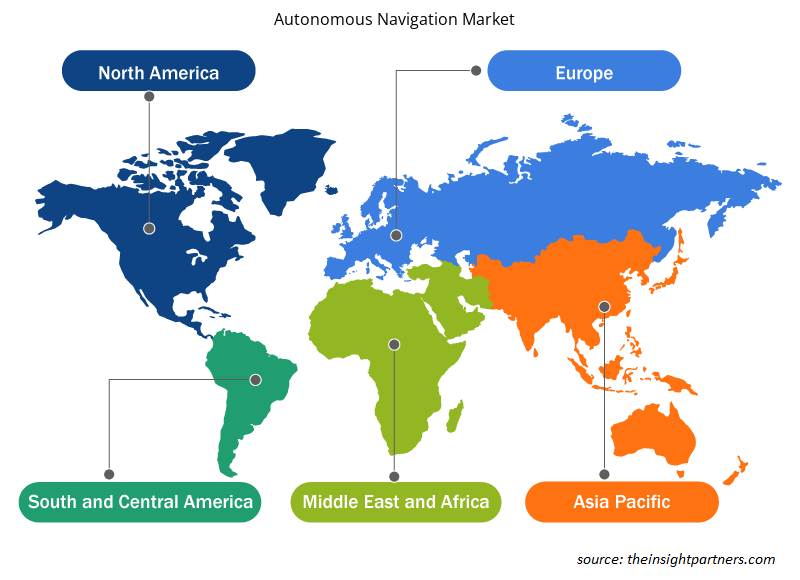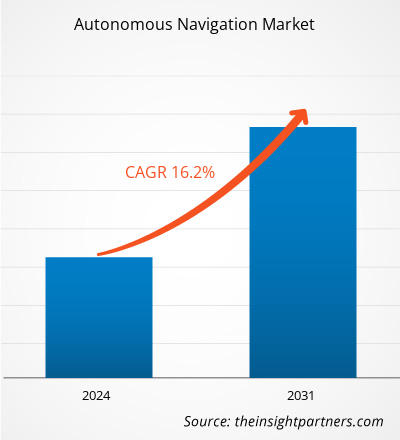من المتوقع أن ينمو حجم سوق الملاحة المستقلة العالمية من 5.20 مليار دولار أمريكي في عام 2023 إلى 17.28 مليار دولار أمريكي بحلول عام 2031؛ ومن المتوقع أن يتوسع بمعدل نمو سنوي مركب قدره 16.2٪ من عام 2024 إلى عام 2031. ومن المرجح أن يظل التركيز المتزايد على أنظمة إدارة حركة المرور غير المأهولة أحد الاتجاهات الرئيسية لسوق الملاحة المستقلة.
تحليل سوق الملاحة المستقلة
كانت المحاولات الجارية لتطوير الأنظمة المستقلة بمثابة محرك أساسي في قطاع الملاحة المستقلة. وقد ساعد تطوير أنظمة الملاحة المستقلة المتقدمة لمجموعة متنوعة من المنصات، بما في ذلك الجوية والبرية والبحرية والفضائية، في دفع توسع السوق.
نظرة عامة على سوق الملاحة المستقلة
نظام الملاحة المستقل هو تقنية معقدة تسمح للمركبات مثل الطائرات بدون طيار والروبوتات والسيارات والقوارب بالتخطيط وتنفيذ مساراتها دون الحاجة إلى تفاعل بشري. يستخدم هذا النظام مجموعة من التقنيات المعقدة، بما في ذلك الملاحة بالقصور الذاتي والملاحة عبر الأقمار الصناعية والرادارات والكاميرات والملاحة بالموجات فوق الصوتية والصوتية ، بالإضافة إلى الخوارزميات القوية، لإصدار أحكام ذكية اعتمادًا على البيئة المحيطة. باستخدام هذه التكنولوجيا المتطورة، يضمن نظام الملاحة المستقل أن تتنقل السيارات بدقة وأمان.
قم بتخصيص هذا التقرير ليناسب متطلباتك
ستحصل على تخصيص لأي تقرير - مجانًا - بما في ذلك أجزاء من هذا التقرير، أو تحليل على مستوى الدولة، وحزمة بيانات Excel، بالإضافة إلى الاستفادة من العروض والخصومات الرائعة للشركات الناشئة والجامعات
-
احصل على أهم اتجاهات السوق الرئيسية لهذا التقرير.ستتضمن هذه العينة المجانية تحليلاً للبيانات، بدءًا من اتجاهات السوق وحتى التقديرات والتوقعات.
محركات وفرص سوق الملاحة المستقلة
التقدم في الأنظمة المستقلة لصالح السوق
ساهمت التحسينات التكنولوجية والدراسة المكثفة بشكل كبير في تطور أنظمة الملاحة ذاتية القيادة. وقد أدت هذه التحسينات إلى الاستخدام الواسع النطاق للمركبات ذاتية القيادة والطائرات بدون طيار والأنظمة الروبوتية في مجموعة متنوعة من الصناعات، بما في ذلك النقل والخدمات اللوجستية والزراعة والتصنيع. توفر الاختراقات التكنولوجية المتزايدة في مجال الملاحة ذاتية القيادة آفاقًا مختلفة لصانعي السيارات ذاتية القيادة. يساعد القرب من أسواق السيارات الكبرى، مثل الولايات المتحدة، بالإضافة إلى اتفاقيات التجارة مثل اتفاقية التجارة الحرة لأمريكا الشمالية (نافتا)، في دفع توسع قطاع الملاحة ذاتية القيادة.
ارتفاع في استخدام الروبوتات المستقلة في التطبيقات التجارية والعسكرية
لقد أدت سهولة الوصول والخدمة الأسرع والصفات الموثوقة للشركات القائمة على منصة التجارة الإلكترونية إلى تسريع توسع قطاع التجارة الإلكترونية بشكل كبير . يمكن أن يُعزى هذا التوسع إلى مجموعة متنوعة من الأسباب، بما في ذلك الاختراقات التكنولوجية والبحث والتطوير الجاري في مجال الروبوتات ورؤية الكمبيوتر والذكاء الاصطناعي والحوسبة الحافة. تلعب الروبوتات المستقلة دورًا مهمًا في التطبيقات العسكرية. يتم استخدامها في مجموعة متنوعة من مهام دعم القتال، بما في ذلك الحرب المضادة للغواصات وزرع الألغام والدعم الناري والحرب الإلكترونية وإدارة أضرار المعارك ومهام الضربات والتزود بالوقود الجوي والمزيد. تساعد هذه الروبوتات القوات العسكرية في جميع أنحاء العالم من خلال استبدال الكشافة البشرية والقيام بمهام محفوفة بالمخاطر أو يصعب على الناس إكمالها.
تقرير تحليل تجزئة سوق الملاحة المستقلة
إن القطاعات الرئيسية التي ساهمت في اشتقاق تحليل سوق الملاحة المستقلة هي الحل والتطبيق ونوع السيارة والمنصة.
- بناءً على الحل، يتم تقسيم السوق إلى نظام الاستشعار ونظام الملاحة ووحدة المعالجة والبرمجيات. احتل قطاع نظام الاستشعار حصة سوقية أكبر في عام 2023.
- من حيث التطبيق، ينقسم السوق إلى قطاع تجاري وقطاع دفاعي. ويستحوذ القطاع التجاري على حصة سوقية أكبر في عام 2023.
- بناءً على نوع السيارة، يتم تقسيم السوق إلى مركبات موجهة آليًا، والروبوتات المتنقلة، والمركبات غير المأهولة، والطائرات بدون طيار، وغيرها. احتلت شريحة المركبات الموجهة آليًا حصة سوقية أكبر في عام 2023.
- بناءً على المنصة، ينقسم السوق إلى برية وبحرية وفضائية. احتلت شريحة الأراضي حصة سوقية أكبر في عام 2023.
تحليل حصة سوق الملاحة المستقلة حسب المنطقة الجغرافية
ينقسم النطاق الجغرافي لتقرير سوق الملاحة المستقلة بشكل أساسي إلى خمس مناطق: أمريكا الشمالية، وآسيا والمحيط الهادئ، وأوروبا، والشرق الأوسط وأفريقيا، وأمريكا الجنوبية/أمريكا الجنوبية والوسطى. سيطرت أمريكا الشمالية على سوق الملاحة المستقلة في عام 2023. ويرجع ذلك إلى أن الطلب المتزايد على النقل الآلي كان محركًا مهمًا لسوق الملاحة المستقلة في أمريكا الشمالية. مع سعي الصناعات والمستهلكين إلى حلول نقل أكثر كفاءة وموثوقية، زاد الطلب على أنظمة الملاحة المستقلة.
رؤى إقليمية حول سوق الملاحة المستقلة
لقد قام المحللون في Insight Partners بشرح الاتجاهات والعوامل الإقليمية المؤثرة على سوق الملاحة المستقلة طوال فترة التوقعات بشكل شامل. يناقش هذا القسم أيضًا قطاعات سوق الملاحة المستقلة والجغرافيا في جميع أنحاء أمريكا الشمالية وأوروبا ومنطقة آسيا والمحيط الهادئ والشرق الأوسط وأفريقيا وأمريكا الجنوبية والوسطى.

- احصل على البيانات الإقليمية المحددة لسوق الملاحة المستقلة
نطاق تقرير سوق الملاحة المستقلة
| سمة التقرير | تفاصيل |
|---|---|
| حجم السوق في عام 2023 | 5.20 مليار دولار أمريكي |
| حجم السوق بحلول عام 2031 | 17.28 مليار دولار أمريكي |
| معدل النمو السنوي المركب العالمي (2024 - 2031) | 16.2% |
| البيانات التاريخية | 2021-2022 |
| فترة التنبؤ | 2024-2031 |
| القطاعات المغطاة |
حسب الحل
|
| المناطق والدول المغطاة |
أمريكا الشمالية
|
| قادة السوق وملفات تعريف الشركات الرئيسية |
|
كثافة اللاعبين في سوق الملاحة المستقلة: فهم تأثيرها على ديناميكيات الأعمال
يشهد سوق الملاحة المستقلة نموًا سريعًا، مدفوعًا بالطلب المتزايد من المستخدم النهائي بسبب عوامل مثل تفضيلات المستهلكين المتطورة والتقدم التكنولوجي والوعي المتزايد بفوائد المنتج. ومع ارتفاع الطلب، تعمل الشركات على توسيع عروضها والابتكار لتلبية احتياجات المستهلكين والاستفادة من الاتجاهات الناشئة، مما يؤدي إلى زيادة نمو السوق.
تشير كثافة اللاعبين في السوق إلى توزيع الشركات أو المؤسسات العاملة في سوق أو صناعة معينة. وهي تشير إلى عدد المنافسين (اللاعبين في السوق) الموجودين في مساحة سوق معينة نسبة إلى حجمها أو قيمتها السوقية الإجمالية.
الشركات الرئيسية العاملة في سوق الملاحة المستقلة هي:
- بلوبوتيكس اس ايه
- شركة يوجين روبوت المحدودة
- كونجسبيرج
- شركة تريمبل
- روبوتات ASI
- كولينز للطيران
إخلاء المسؤولية : الشركات المذكورة أعلاه ليست مرتبة بأي ترتيب معين.

- احصل على نظرة عامة على أهم اللاعبين الرئيسيين في سوق الملاحة المستقلة
أخبار سوق الملاحة المستقلة والتطورات الأخيرة
يتم تقييم سوق الملاحة المستقلة من خلال جمع البيانات النوعية والكمية بعد البحث الأولي والثانوي، والتي تتضمن منشورات الشركات المهمة وبيانات الجمعيات وقواعد البيانات. فيما يلي قائمة بالتطورات في السوق:
- في يونيو 2022، أطلقت BlueBotics موقع ANTdriven.com، وهو مورد تعليمي جديد يهدف إلى مساعدة المحترفين في بدء رحلاتهم في مجال المركبات الموجهة آليًا. توفر المنصة محتوى تعليميًا واضحًا ومفيدًا وأدوات مفيدة، كما تقدم استشارات مجانية من الخبراء. تم تصميمه لمساعدة المشترين المحتملين في التغلب على التحديات وإيجاد المركبات الآلية الأكثر ملاءمة لأعمالهم. يتميز موقع ANTdriven.com بمجموعة واسعة من المحتوى لتناسب كل زائر، بغض النظر عن مكانه في رحلته في مجال المركبات الموجهة آليًا.
(المصدر: BlueBotics، بيان صحفي، 2022)
تقرير سوق الملاحة المستقلة - التغطية والنتائج المتوقعة
يوفر تقرير "حجم سوق الملاحة المستقلة والتوقعات (2021-2031)" تحليلاً مفصلاً للسوق يغطي المجالات التالية:
- حجم السوق والتوقعات على المستويات العالمية والإقليمية والوطنية لجميع قطاعات السوق الرئيسية التي يغطيها النطاق
- ديناميكيات السوق مثل المحركات والقيود والفرص الرئيسية
- الاتجاهات المستقبلية الرئيسية
- تحليل مفصل لقوى PEST/Porter الخمس وSWOT
- تحليل السوق العالمي والإقليمي الذي يغطي اتجاهات السوق الرئيسية واللاعبين الرئيسيين واللوائح والتطورات الأخيرة في السوق
- تحليل المشهد الصناعي والمنافسة الذي يغطي تركيز السوق، وتحليل خريطة الحرارة، واللاعبين البارزين، والتطورات الأخيرة
- ملفات تعريف الشركة التفصيلية
- التحليل التاريخي (سنتان)، سنة الأساس، التوقعات (7 سنوات) مع معدل النمو السنوي المركب
- تحليل PEST و SWOT
- حجم السوق والقيمة / الحجم - عالمي، إقليمي، بلد
- الصناعة والمنافسة
- مجموعة بيانات إكسل
التقارير الحديثة
شهادات العملاء
سبب الشراء
- اتخاذ قرارات مدروسة
- فهم ديناميكيات السوق
- تحليل المنافسة
- رؤى العملاء
- توقعات السوق
- تخفيف المخاطر
- التخطيط الاستراتيجي
- مبررات الاستثمار
- تحديد الأسواق الناشئة
- تحسين استراتيجيات التسويق
- تعزيز الكفاءة التشغيلية
- مواكبة التوجهات التنظيمية























 احصل على عينة مجانية ل - سوق الملاحة المستقلة
احصل على عينة مجانية ل - سوق الملاحة المستقلة